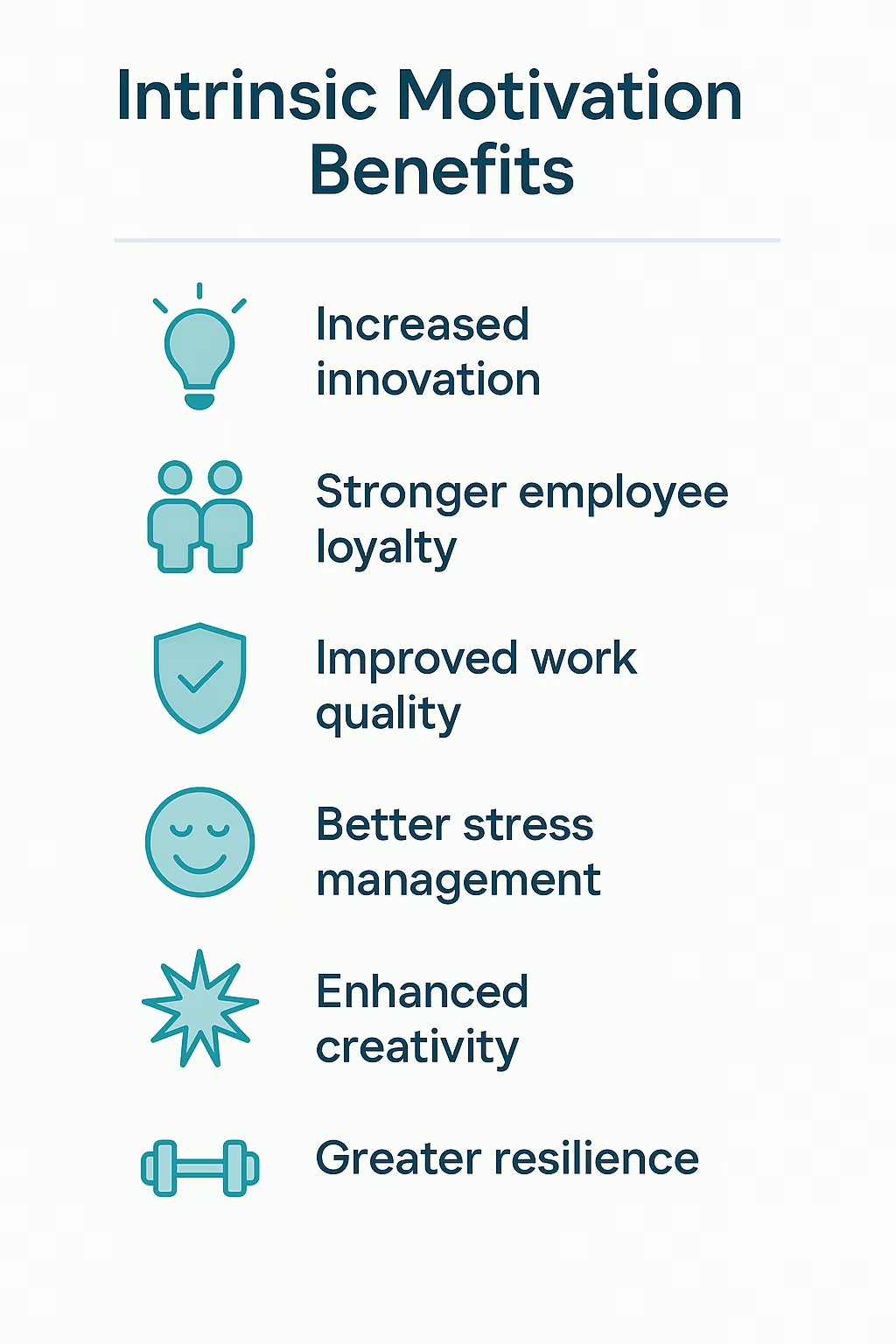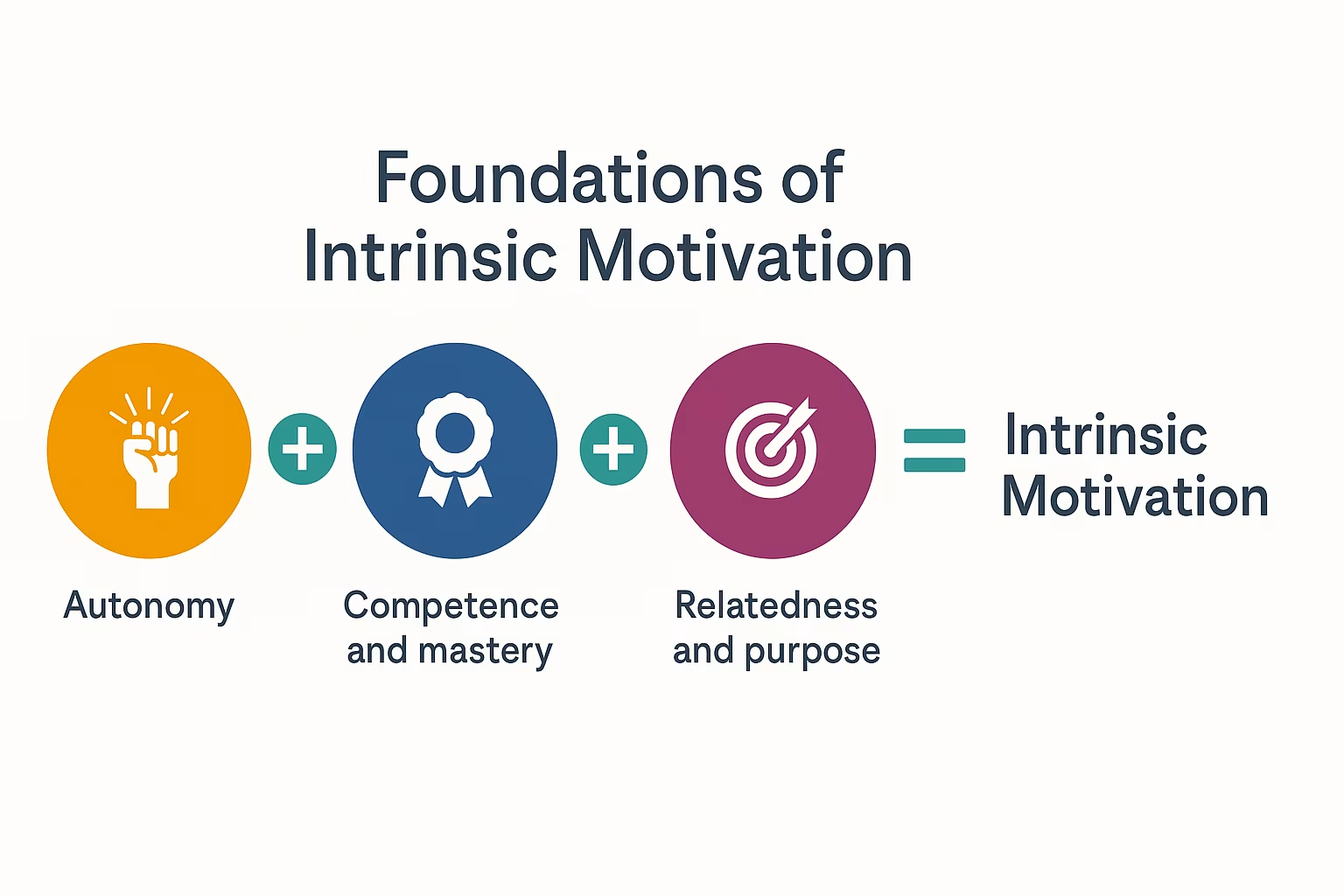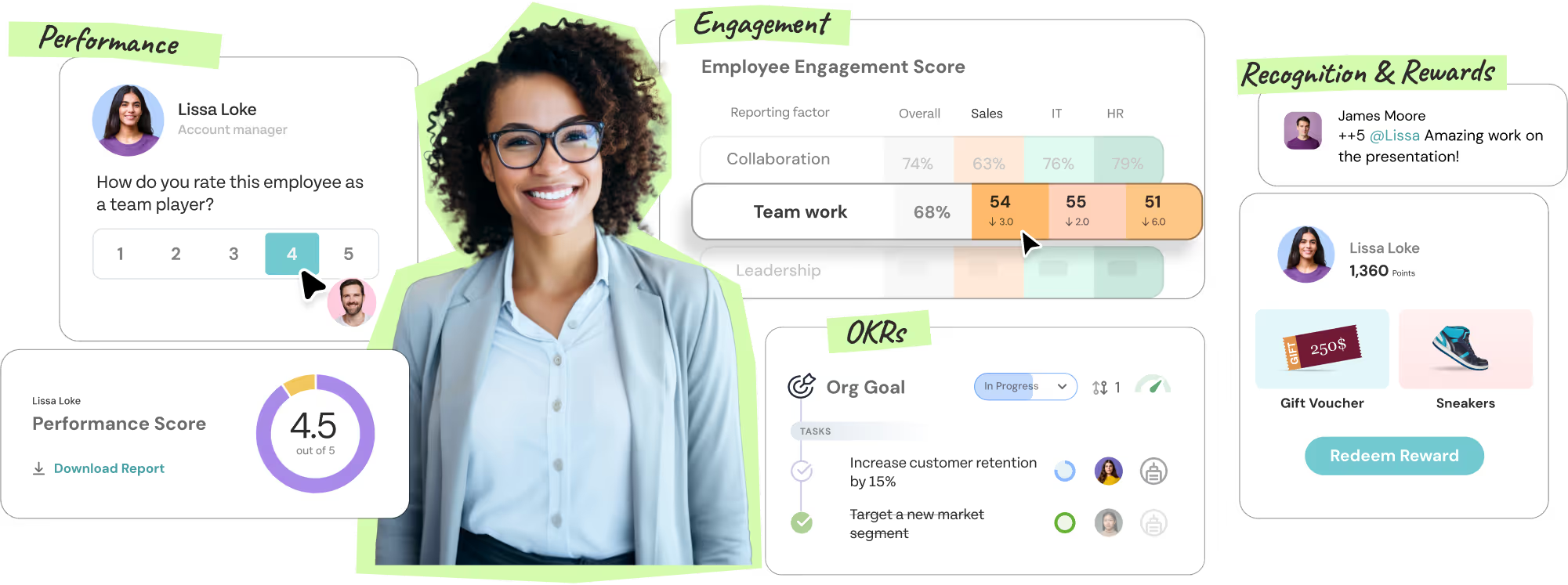Looking for ways to motivate your employees beyond salary increases and performance bonuses? Intrinsic motivation might be exactly what your workplace needs. Research shows that employees driven by internal satisfaction—like personal growth, meaningful work, and autonomy—consistently outperform those motivated solely by external rewards.
This guide will show you what intrinsic motivation looks like in action, why it's more sustainable than traditional incentives, and practical methods to cultivate it within your team for lasting employee engagement strategies.
What Is Intrinsic Motivation
Intrinsic motivation comes from doing something because it is inherently satisfying or interesting, rather than to obtain external rewards or avoid punishment. In the workplace, intrinsically motivated employees perform better, learn faster and stay longer because they derive genuine satisfaction from their work and experience three universal psychological needs described by self‑determination theory.
These three fundamental needs are autonomy (having choice in how you carry out work), competence (feeling effective and skilled), and relatedness (connection and belonging to others). When fulfilled, people naturally strive to excel and continue learning. Without them, even interesting work can feel mechanical or draining.
Intrinsically motivated employees are driven by satisfaction, enjoyment, workplace challenges, learning opportunities, recognition of their abilities, and alignment with organizational values rather than just external rewards like pay or bonuses.
Intrinsic Motivation Benefits for organizations
Employees who are intrinsically motivated put in more effort, take initiative and show greater creativity. Studies show that recognition and feeling appreciated are stronger drivers of engagement than cash bonuses. When organizations build cultures that satisfy autonomy, mastery and purpose, they enjoy higher productivity, lower turnover and stronger financial performance.
Research shows that intrinsically motivated employees develop several key advantages that directly benefit organizations :
- Increased innovation - Employees driven by internal satisfaction are more likely to engage in innovative thinking and explore new ideas
- Stronger employee loyalty - Deep emotional connections to work reduce turnover rates and create company advocates
- Improved work quality - Pride in work leads to higher quality outputs and more meticulous attention to detail
- Better stress management - Genuine interest in work helps employees view challenges as growth opportunities
- Enhanced creativity - Freedom from external pressure allows teams to embrace risks and explore new solutions
- Greater resilience - Internal motivation helps teams overcome setbacks and maintain consistent effort

Foundations of Intrinsic Motivation: Self‑Determination Theory
Self‑Determination Theory (SDT) by psychologists Edward Deci and Richard Ryan offers a helpful framework for understanding intrinsic motivation. Developed in the 1980s, SDT posits that humans flourish when three basic psychological needs are met: autonomy, competence and relatedness. Fulfilling these needs creates conditions where intrinsic motivation naturally emerges.

Autonomy – giving employees control
People are intrinsically motivated when they feel they have choices and control over their work. SDT notes that autonomy involves having a say in what you do and framing goals as essential to your personal success.
Practical ways to support autonomy include:
1. Flexible work arrangements - Offer options like hybrid or remote work. Harvard researchers report that employees value flexible schedules and intangible benefits more than higher pay.
2. Outcome‑based goals - Set clear outcomes but let employees choose how to achieve them. This empowers people to plan workloads and solve challenges creatively.3
3. Psychological safety - Encourage feedback and make it safe to take risks. Creating a culture where mistakes are viewed as learning opportunities helps employees feel trusted.
Competence and mastery – enabling growth
Feeling effective and continually improving fuels intrinsic motivation. SDT research shows that providing resources for learning, setting learning goals rather than just results and asking "how did you grow today?" boosts perceptions of competence.
Organizations can cultivate mastery by:
1. Continuous learning programs - Offer training budgets, online courses or rotation programs so employees can build new skills. Encouraging self‑directed learning gives people chances to pursue their curiosity.
2. Stretch assignments - Give team members challenging projects that expand their skill sets. These assignments build confidence while creating satisfying achievement moments.
3. Constructive feedback - Provide specific praise for effort and strategies rather than just outcomes. Specific, sincere feedback helps people persist through challenges.
Related read: How to Give Constructive Feedback, examples and tips

Relatedness and purpose – connecting the work to something bigger
Humans crave meaningful relationships and a sense that their work matters. Relatedness involves deepening connections with colleagues and linking tasks to a higher cause.
Ways to foster relatedness include:
1. Shared mission and storytelling - Frame everyday tasks within the organization's broader mission. Engaging people with narratives—such as building a church rather than simply laying bricks—helps them see significance in mundane tasks.
2. Servant leadership - Adopting a mindset of serving staff rather than controlling them helps employees feel supported. Leaders who put employees' needs first foster loyalty and passion.
3. Peer-to-Peer Recognition - Encourage employees to recognize each other's contributions. Recognition programs strengthen bonds, and Harvard research notes that feeling appreciated motivates employees more than financial incentives.

Practical Strategies to Foster Intrinsic Motivation
Building intrinsic motivation requires more than isolated perks; it involves creating a holistic environment where autonomy, mastery and purpose are integrated into daily routines. Below are research‑backed strategies that organizations can implement.
1. Be a leader, not just a manager
Leaders inspire by connecting their team's personal values to the organization's goals. Managers should shift from task controllers to coaches who help people see the meaning behind their tasks.
For example, instead of telling a team "we must finish this project because management expects it," tie the project to customer impact or community benefit. Leaders should empower team members to embrace their own leadership abilities and take ownership of shared goals.
Related: The Impact of Leadership at Workplace Dynamics
2. Provide autonomy and build trust
Employee autonomy is only effective when combined with trust. Managers can support autonomy by clarifying desired outcomes and letting employees determine how to achieve them. Encourage open feedback, recognize initiative and create psychological safety so people feel comfortable taking risks.
Building trust also requires demonstrating integrity—keeping promises, being transparent and involving employees in decisions. When workers trust their leaders, they are more willing to go the extra mile and innovate.
3. Recognize and reward meaningfully
Recognition is a powerful intrinsic motivator when it signals genuine appreciation. Research from Harvard Business School shows that employees crave appreciation more than cash; recognition programs increase productivity and reduce turnover. Effective practices include:
Immediate, specific praise - Thank employees immediately after they do something noteworthy and explain why their contribution matters.
Personalized gifts or notes - A handwritten note or a meaningful, non‑cash gift can be more motivating than a generic bonus.
Peer‑to‑peer recognition - Use tools or ceremonies where colleagues can applaud each other's efforts, strengthening social bonds and relatedness.
4. Encourage continuous learning and mastery
Mastery is cultivated when people are challenged and supported to grow. Provide resources for learning and encourage employees to set learning goals instead of just performance targets. Organizations can run hackathons, lunch‑and‑learn sessions or cross‑training programs. Mentor relationships are also powerful; employees who mentor peers often feel intrinsically motivated because they derive satisfaction from helping others succeed.
5. Create a purpose‑driven culture
Employees work harder when they understand how their efforts contribute to a larger purpose. Leaders should regularly communicate the company's mission and connect individual tasks to that mission. Storytelling helps; describing how a small code change improves user experience or how a marketing campaign supports a charitable cause can inspire engagement. Providing opportunities for employees to contribute to social or environmental initiatives is another way to align work with purpose.
6. Use extrinsic rewards wisely
While extrinsic rewards such as bonuses have their place, they should be used carefully. Self‑determination research warns that excessive external incentives can reduce intrinsic interest—a phenomenon called the overjustification effect. Rewarding someone who is intrinsically motivated with extrinsic rewards can lead them to lose interest in the activity.
Therefore, tie extrinsic rewards to recognition rather than coercion, and avoid conditional rewards that make pay contingent on performance. Focus on intangible perks like flexible schedules, personal growth opportunities and meaningful recognition.
7. Design a motivating work environment
People are more likely to feel intrinsically motivated in environments where they are comfortable and healthy. Creating comfortable workspaces, ensuring remote employees have a healthy setup and offering flexible schedules to support work‑life balance all contribute to intrinsic motivation. Allowing time off reduces stress and increases creativity and engagement. Organizations can also foster camaraderie through team‑building activities, collaborative spaces and open communication channels.
Avoiding Pitfalls and Common Misconceptions
One common misconception is that extrinsic and intrinsic motivation are mutually exclusive; in reality they exist on a spectrum. A mixed approach can work when extrinsic rewards complement rather than replace intrinsic drivers.
However, leaders should avoid the overjustification effect by ensuring that external rewards do not become the primary reason for doing the work. Another pitfall is assuming that one strategy fits all. Individuals differ in what makes them feel autonomous, competent and connected. Good managers ask questions to uncover what excites their employees and adapt strategies accordingly.
Building intrinsic motivation isn't about implementing one-size-fits-all solutions—it's about creating an environment where people naturally want to contribute their best work. When you focus on giving employees meaningful choices, opportunities to grow, and genuine connections to purpose, you're not just improving workplace satisfaction—you're building the kind of sustainable culture that drives long-term success
ThriveSparrow helps organizations build intrinsically motivated teams through comprehensive feedback systems, peer recognition tools, and engagement insights that support the three pillars of motivation: autonomy, competence, and relatedness.

Ready to transform your workplace culture and unlock your team's natural motivation?
Start your 14-day free trial with ThriveSparrow and see how the right employee success platform can help you create an environment where people thrive from within—no credit card required.
FAQs
1. What are the core elements of intrinsic motivation?
Self‑determination theory identifies autonomy, competence and relatedness as the three needs that underpin intrinsic motivation.
2. How can managers encourage intrinsic motivation at work?
Leaders can empower autonomy, provide growth opportunities, recognize contributions and connect tasks to the organization's purpose.
3. What are examples of intrinsic motivation in the workplace?
Examples include employees taking initiative, seeking feedback, mentoring peers and pursuing self‑directed learning because they find the work meaningful.
4. Can extrinsic rewards harm intrinsic motivation?
Yes. Excessive external rewards can produce the overjustification effect, reducing intrinsic interest in the task.
5. Why is recognition more motivating than cash bonuses?
Research shows employees crave appreciation and intangible benefits; recognition programs increase productivity and retention more effectively than cash incentives alone.
















